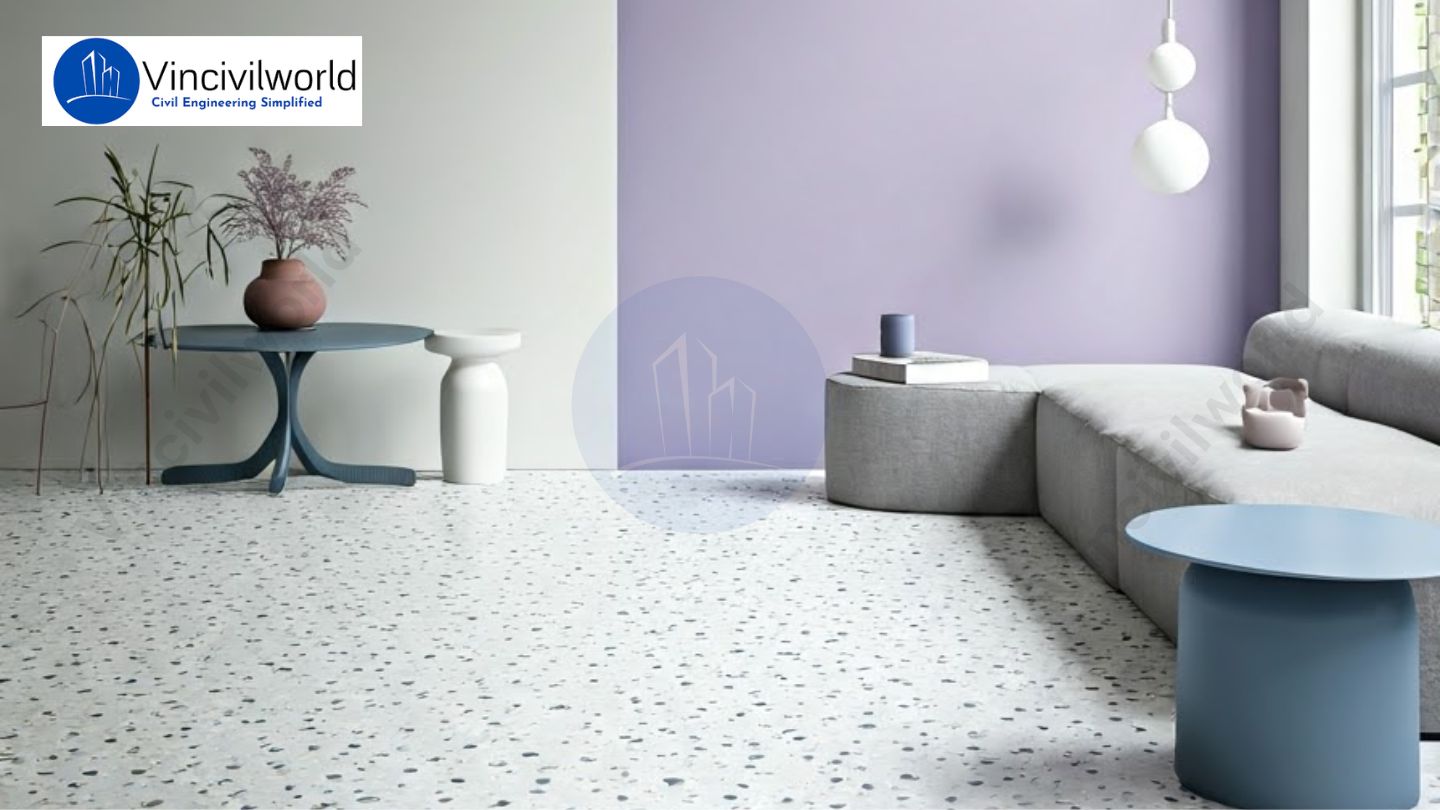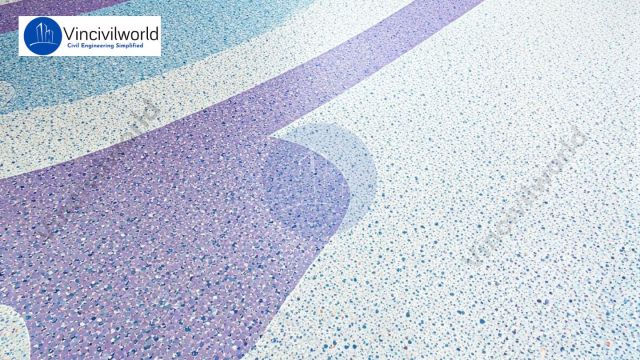Terrazzo flooring is a popular choice for both residential and commercial spaces. It consists of chips of marble, granite, quartz, or glass, embedded in a cement or epoxy base. This flooring offers a sleek and durable finish, making it a long-lasting solution for high-traffic areas. Terrazzo floor tiles are easy to install and maintain, offering flexibility in design with various color options. Epoxy terrazzo flooring, in particular, is known for its durability and resistance to chemicals, making it ideal for industrial and healthcare settings.
Compared to mosaic flooring, terrazzo flooring has a smoother, more seamless appearance, as mosaic tiles involve more intricate designs with smaller pieces. Terrazzo floors can be customized to create unique patterns, adding aesthetic value to any space. Whether you’re looking for practicality or style, terrazzo flooring offers a versatile option that blends durability and design.
In this article, we will describe the types and ingredients of terrazzo flooring, including epoxy terrazzo flooring and cementitious or traditional terrazzo flooring. We will also highlight the advantages of terrazzo flooring over cementitious terrazzo flooring. This comprehensive guide will help you understand the key differences, materials used, and why epoxy terrazzo flooring stands out for modern applications.
Table of contents
History of Terrazzo Flooring
Terrazzo flooring has ancient origins, dating back to Venetian palaces and Roman mosaics. By the 15th century, terrazzo floor tiles became popular across Europe in both residential and public spaces. In the 20th century, terrazzo experienced a modern revival due to its versatility, durability, and aesthetic appeal. Today, conventional terrazzo tiles and epoxy terrazzo floors offer vibrant design possibilities and seamless finishes, making these flooring a preferred choice for modern architecture, combining historic craftsmanship with contemporary innovation.
Terrazzo flooring – Ingredients and types
Terrazzo flooring incorporates a mix of materials such as marble, quartz, granite, or glass chips, creating a visually striking and versatile floor. Its popularity stems from its exceptional durability, easy maintenance, and ability to be customized to suit any aesthetic, making it a preferred choice for architects and designers.
These flooring comes in various styles, each offering unique characteristics and visual appeal. From traditional cement-based options to epoxy terrazzo flooring.
Traditional Terrazzo: This uses a cement binder mixed with marble, quartz, or other aggregates. It delivers a classic, timeless look.
Epoxy Terrazzo: Instead of cement, this type uses epoxy resin as the binder. Epoxy terrazzo flooring provides greater design flexibility, enhanced durability, and a smoother finish.
Venetian Terrazzo: Originating in Italy, this features intricate patterns created with colorful marble chips set in a cement binder, offering a polished finish.
Rustic Terrazzo: This type has a more textured, natural look. It often includes larger aggregate chips for a rustic, earthy appearance.
Aggregate Terrazzo: It mixes a single type of aggregate, like marble or recycled glass, with a binder, resulting in a uniform, minimalist design.
Monolithic Terrazzo: Poured on-site, this seamless terrazzo floor offers endless design possibilities.
These types showcase the versatility compared to options like mosaic floor. These are just a few examples, as these floors can be customized to meet specific design preferences. This allows for an extensive range of variations and combinations.
Epoxy terrazzo Flooring
Epoxy terrazzo flooring is a popular option known for its durability, versatility, and seamless finish. It uses an epoxy resin binder combined with aggregates like marble, quartz, or glass chips, creating a highly customizable surface. Epoxy terrazzo is resistant to stains, chemicals, and moisture, making it perfect for high-traffic areas and modern design schemes.
Advantages and Applications of Epoxy Terrazzo Floor
Epoxy terrazzo flooring offers several advantages and is widely used in various settings. Its seamless finish eliminates grout lines, making maintenance easier and preventing dirt and bacteria build-up. This type of floor is highly durable, resistant to chemicals, stains, and impact. Its design flexibility allows for intricate patterns and vibrant colors, offering limitless possibilities. Epoxy terrazzo is commonly used in commercial spaces like airports, hospitals, schools, and retail stores due to its long-lasting performance. Residential projects also favor it for its aesthetic appeal and easy upkeep. Compared to mosaic , these type of floor offers a smoother, more contemporary look, with increased durability and fewer maintenance demands.
Cementitious Terrazzo Flooring
Cementitious terrazzo flooring comes in various types, each offering unique characteristics. Common types include Venetian terrazzo, which features intricate patterns and colourful marble chips; rustic terrazzo, known for its textured and natural appearance; and aggregate terrazzo, using a single type of aggregate like recycled glass or marble chips for a minimalist design. These variations allow for a wide range of aesthetic options to suit different preferences.
Monolithic terrazzo is poured on-site without separate installation or precast elements. It provides a seamless and continuous surface, allowing for unlimited design possibilities and a visually cohesive look.
Epoxy Terrazzo vs Cementitious Terrazzo Floor
Here’s a comparison between epoxy terrazzo and cementitious terrazzo flooring in tabular form:
| Feature | Epoxy Terrazzo | Cementitious Terrazzo |
|---|---|---|
| Durability | Superior chemical and stain resistance; highly resistant to wear and tear. | Less resistant to chemicals and stains, more prone to wear. |
| Design Versatility | Offers vibrant colors, intricate patterns, and decorative effects. | More limited design options and color choices. |
| Seamless Finish | Provides a seamless finish without grout lines, easy to clean. | May have grout lines, harder to maintain. |
| Installation Time | Faster installation with less curing time. | Slower installation, requires more curing time. |
| Cost | Generally more cost-effective, depending on design and size. | Can be more expensive depending on project specifics. |
Note: The choice depends on project requirements and design preferences.
Advantages of Terrazzo Flooring
Terrazzo floor offers several advantages over other popular choices:
- Durability: Terrazzo is highly durable and long-lasting, surpassing materials like laminate, vinyl, or carpet.
- Design Options: Terrazzo provides endless design possibilities with customizable colours, patterns, and aggregates, unlike the limited options of hardwood or tile.
- Low Maintenance: Terrazzo requires minimal maintenance, with easy cleaning and resistance to stains and scratches, unlike carpet or natural stone.
- Sustainability: Terrazzo is eco-friendly, often using recycled materials and reducing waste, making it a greener choice compared to some floor options.
- Versatility: Terrazzo can be used both indoors and outdoors, accommodating various spaces, while materials like carpet or hardwood may have limited outdoor usage.
- Allergen Reduction: Unlike carpet, terrazzo does not trap allergens and is hypoallergenic, promoting a healthier indoor environment.
- Longevity: Terrazzo has a long lifespan, exceeding the durability of materials like laminate or vinyl, offering a cost-effective solution over time.
Terrazzo’s unique blend of durability, aesthetic appeal, low maintenance, and sustainability make it stand out among popular flooring choices.
Design Possibilities with Terrazzo
Terrazzo offers a wealth of design possibilities, allowing for unique and creative expressions in flooring. Here are three popular design options:
a) Geometric Patterns
Create striking geometric patterns that add a modern and sophisticated touch to any space.
b) Natural Stone Look
Achieve a timeless and elegant look that blends seamlessly with nature, providing an organic feel to the environment.
c) Vibrant Color Combinations
Incorporate bold and vibrant color combinations to create eye-catching designs that enhance the visual appeal of a space and make a statement.
Comparison between terrazzo and mosaic flooring
Terrazzo flooring offers a unique blend of durability, design flexibility, and low maintenance, making it a superior alternative to traditional mosaic in various settings as follows
| Basis of Comparison | Terrazzo Flooring | Marble Flooring |
|---|---|---|
| Durability | Highly durable; resistant to wear, scratches, and stains. | Softer material; more prone to scratches and damage. |
| Maintenance | Requires less maintenance; easier to clean and care for. | Requires regular sealing to protect against stains. |
| Design Flexibility | Offers a wide range of colors, patterns, and materials. | Limited design options; typically available in natural patterns. |
| Cost-Effectiveness | Generally more cost-effective, especially for custom designs. | Can be more expensive due to quarrying and finishing costs. |
| Environmental Considerations | Often made with recycled materials; more eco-friendly. | Typically quarried, leading to greater environmental impact. |
| Seamless Finish | Can be installed seamlessly, eliminating grout lines. | Usually has visible seams; grout lines can be difficult to clean. |
| Versatility | Suitable for various settings, including outdoor areas. | Best suited for indoor use; not ideal for high-moisture areas. |
This comparison highlights the strengths and weaknesses of both options, showcasing why terrazzo may be the superior choice for many applications.
Key Takeaways
- Versatile Choice: Suitable for both residential and commercial spaces.
- Durable Materials: Made of marble, quartz, granite, or glass chips in a cement or epoxy base.
- Types of Terrazzo: Includes traditional, epoxy, Venetian, rustic, aggregate, and monolithic terrazzo.
- Seamless Finish: Epoxy terrazzo features a seamless appearance and easy maintenance.
- Stain and Chemical Resistance: Highly resistant to stains and chemicals, ideal for high-traffic areas.
- Design Flexibility: Offers unique possibilities, including geometric patterns and vibrant colors.
- Eco-Friendly: Often made using recycled materials, promoting sustainability.
- Low Maintenance: Requires minimal upkeep compared to other flooring options.
- Longevity: Provides a long lifespan, ensuring cost-effectiveness.
Conclusion
In summary, this type of flooring is an exceptional choice that blends durability with design versatility, catering to diverse aesthetic preferences. Its rich history, originating from ancient Roman and Venetian techniques, has evolved into a modern flooring solution that is both functional and stylish. The various types of flooring, especially epoxy options, offer unique features that enhance both residential and commercial environments. With an array of design possibilities, including geometric patterns, natural stone looks, and vibrant color combinations, they allows for creative expression while ensuring longevity and low maintenance. Embracing these flooring means investing in a sustainable, enduring, and visually stunning flooring solution that stands the test of time and economical.





